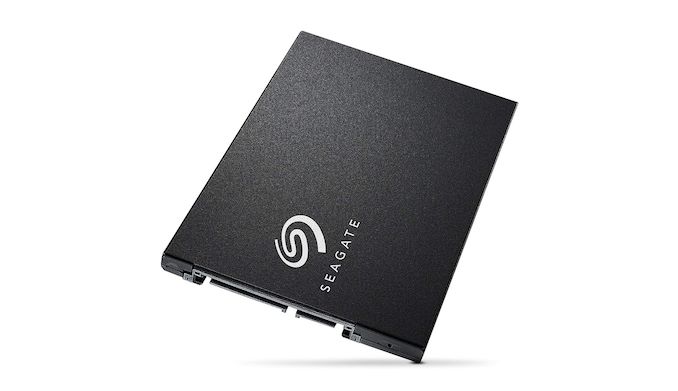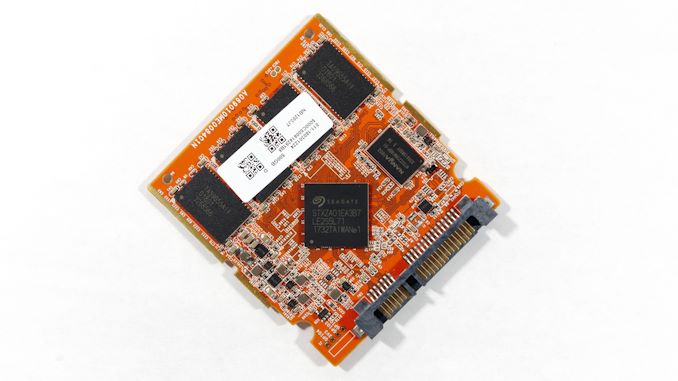The Seagate BarraCuda (500GB) SSD Review: Getting Back In The Game
by Billy Tallis on December 7, 2018 8:00 AM EST
Earlier this year, Seagate re-entered the consumer SSD market with their BarraCuda SATA SSD. It's been over five years since we last reviewed a Seagate consumer SSD, so for all practical purposes this is a fresh start for the company.
Seagate has been one of the top names in the storage industry for decades, but it's almost exclusively for their hard drives. The company has been largely absent from the consumer SSD market, and their enterprise SSDs have never particularly stood out above the competition. By comparison, rival Western Digital managed to acquire SanDisk and with it a 50% stake in one of the largest NAND flash manufacturers. Seagate's acquisitions have been less fruitful: they bought controller designer SandForce right around when SandForce drives disappeared from the market for good. Since then, Seagate has had to buy controllers and NAND on the open market and provide product differentiation through firmware or by integrating their drives into storage appliances.
The Seagate BarraCuda is not a revolutionary new SSD. It doesn't mark the release of a new SandForce controller but instead uses the very familiar and rather old Phison S10 controller. The flash is Toshiba's 64-layer 3D TLC NAND. Toshiba for their past has technically already started shipping their 96-layer TLC, but most of their production is still 64L and the 96L NAND hasn't made it into any retail SSDs yet, so the BarraCuda is up to date on the NAND choice.
This is the first drive we've tested that pairs the Phison S10 controller with 3D NAND. We first reviewed this controller in 2014, so it has had an incredibly long lifespan for such a product. With the SATA interface no longer getting speed increases, the Phison S10 isn't as obviously outclassed as such an old controller would otherwise be. It's showing its age a bit with the lack of LDPC error correction or (LP)DDR4 support, but it has proven to be an adaptable chip, supporting several generations of planar NAND and staying relevant today with support for 3D NAND. It also supports SSD capacities of up to 2TB, which was extremely implausible for a consumer drive with the flash prices in 2014, but which are now available for less than $300.
| Seagate BarraCuda SSD Specifications | ||||||
| Capacity | 250 GB | 500 GB | 1 TB | 2 TB | ||
| Form Factor | 2.5" 7mm SATA | |||||
| Controller | Seagate-branded Phison S10 | |||||
| NAND Flash | Toshiba 64L 3D TLC | |||||
| DRAM | Nanya DDR3-1600 CL11, 1.35V | |||||
| Sequential Read | 560 MB/s | |||||
| Sequential Write | 530 MB/s | 535 MB/s | 540 MB/s | 540 MB/s | ||
| Random Read | 90k IOPS | |||||
| Random Write | 90k IOPS | |||||
| Power | Active | 2.6 W | 2.6 W | 2.8 W | 3.1 W | |
| Idle | 185 mW | 192 mW | 221 mW | 225 mW | ||
| DevSleep | 5 mW | |||||
| Warranty | 5 years | |||||
| Write Endurance | 120 TB 0.26 DWPD |
249 TB 0.27 DWPD |
485 TB 0.27 DWPD |
1067 TB 0.29 DWPD |
||
| Current Retail Price | $52.99 (21¢/GB) | $84.99 (17¢/GB) | $149.99 (15¢/GB) | $349.99 (17¢/GB) | ||
The specifications for the Seagate BarraCuda look about the same as any other mainstream SATA SSD these days: TLC NAND, sequential I/O performance that mostly saturates the SATA link, and random I/O performance at up to 90k IOPS. But real-world performance depends more on performance at low queue depths and on mixed workloads, not peak numbers at QD32. This is where newer SSD controllers may have an edge over the Phison S10.
The BarraCuda is rated for a little under 0.3 drive writes per day over the duration of its 5-year warranty. We can be pretty sure that the controller can keep going that long because our earliest Phison S10 drives closing in on that age without problems. However, without the benefit of LDPC error correction, Seagate's write endurance rating isn't as conservative as the 0.3 DWPD we see on its competition.
The Seagate BarraCuda actually uses a controller chip bearing Seagate's logo and part number, but we've seen this same basic board layout many times and in many colors. Seagate is hardly the only company that rebrands off the shelf controllers. The Phison S10 is an 8-channel controller so we get 8 NAND packages, with two 256Gb dies in each package. The metal case for the drive is the same that we're used to seeing on Phison S10 drives, but with yet another variation on the paint job.
The main competitors for the Seagate BarraCuda are mainstream SATA drives like the Crucial MX500, Samsung 860 EVO, Intel 545s, and WD Blue/SanDisk Ultra 3D. These all feature 64-layer 3D NAND but more recent SSD controllers. For this review we've also included a pair of current-generation DRAMless SATA SSDs: the Mushkin Source and the Toshiba TR200, the latter of which uses the same NAND as the BarraCuda but Phison's S11 4-channel entry-level SATA SSD controller. We've also thrown in results for some older drives that used the Phison S10 controller with planar NAND: the Toshiba OCZ Trion 150 with 15nm TLC, and the PNY CS2211 with 15nm MLC.
Perhaps the most interesting point of comparison is the Plextor M8V, a drive that's generally hard to find for sale, but is very useful here because it uses the same Toshiba 3D TLC NAND but pairs it with the Silicon Motion SM2258 controller instead of the Phison S10. This helps identify which performance differences are due to the choice of NAND and which are controller or firmware bottlenecks.
| AnandTech 2018 Consumer SSD Testbed | |
| CPU | Intel Xeon E3 1240 v5 |
| Motherboard | ASRock Fatal1ty E3V5 Performance Gaming/OC |
| Chipset | Intel C232 |
| Memory | 4x 8GB G.SKILL Ripjaws DDR4-2400 CL15 |
| Graphics | AMD Radeon HD 5450, 1920x1200@60Hz |
| Software | Windows 10 x64, version 1709 |
| Linux kernel version 4.14, fio version 3.6 | |
| Spectre/Meltdown microcode and OS patches current as of May 2018 | |
- Thanks to Intel for the Xeon E3 1240 v5 CPU
- Thanks to ASRock for the E3V5 Performance Gaming/OC
- Thanks to G.SKILL for the Ripjaws DDR4-2400 RAM
- Thanks to Corsair for the RM750 power supply, Carbide 200R case, and Hydro H60 CPU cooler
- Thanks to Quarch for the XLC Programmable Power Module and accessories
- Thanks to StarTech for providing a RK2236BKF 22U rack cabinet.















39 Comments
View All Comments
Hulk - Friday, December 7, 2018 - link
Fantastic review as always. Thanks for your hard work.But I'm curious as to why the Samsung EVO 860 isn't in the benchmarks. It was recently selling for under $130 (not back at $150) and seems to be the benchmark to which most drives in this category should be compared?
Gasaraki88 - Friday, December 7, 2018 - link
The 850 EVO and 860 EVO are very similar in performance.Samus - Friday, December 7, 2018 - link
The problem for Samsung's consumer market is they've been making drives that max out the capabilities of SATA for 5 years. There just isn't much more room to improve.And the problem for Samsung's prosumer market is the WD Black NVMe is an overall better value than the 970 NVMe, ESPECIALLY in mobile where the 970's (even the EVO) are so power hungry they constantly throttle in laptops, while reducing battery life.
Samsung is riding on reputation right now. Superior products in the SATA space are irrelevant because at the high end you wont notice a real difference between SATA drives. And in the NVMe space, there are plenty of players on par with Samsung.
zodiacfml - Monday, December 10, 2018 - link
I used to think that SATA is dumb for recent SSDs. However, I noticed that it is only for sequential workloads which can be left running in the background. SATA still has a lot of life for SSDs.The 2.5" form factor is still dumb though. It is huge waste of space and materials.
Can't they make the case the size of the PCB using only the first pair of screws for mounting?
derekullo - Monday, December 10, 2018 - link
The reason this was done was to safe on space knowing that eventually they would deployed in laptops.Another reason was that when ssds were first being released with SLC, they were incredibly expensive and nobody could afford to buy your 1 Terabyte 3.5" drive filled to the brim with SLC nand. Of course we can afford it now ...
derekullo - Monday, December 10, 2018 - link
save on space* be deployed*Billy Tallis - Friday, December 7, 2018 - link
My smallest 860 EVO sample is 1TB, and I didn't want to put that on the graphs as the only drive of that capacity. Performance generally increases with drive capacity, so the 1TB would exaggerate the performance advantage of the 860 EVO over the BarraCuda (and probably slightly understate the efficiency advantage). You can make the comparison with our Bench tool if you're interested: https://www.anandtech.com/bench/product/2201?vs=21...Hulk - Friday, December 7, 2018 - link
Okay that makes sense.Death666Angel - Friday, December 7, 2018 - link
2.5" SATA SSDs should just become M.2 SATA SSDs with a caddy. :)Dragonstongue - Friday, December 7, 2018 - link
not everyone has m.2 on their boards and many of those boards overheat the drive in that slot anyways....t each own, "slow" drives are best kept as full out SATA sized drive (which vast majority are 2.5" anyways. the samsung 8/9xx are "unique" in that the pcb housing the memory chips etc is quite small compared to many so they "easily" put on a m.2 "gum stick"